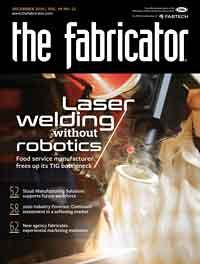Senior Editor
- FMA
- The Fabricator
- FABTECH
- Canadian Metalworking
Categories
- Additive Manufacturing
- Aluminum Welding
- Arc Welding
- Assembly and Joining
- Automation and Robotics
- Bending and Forming
- Consumables
- Cutting and Weld Prep
- Electric Vehicles
- En Español
- Finishing
- Hydroforming
- Laser Cutting
- Laser Welding
- Machining
- Manufacturing Software
- Materials Handling
- Metals/Materials
- Oxyfuel Cutting
- Plasma Cutting
- Power Tools
- Punching and Other Holemaking
- Roll Forming
- Safety
- Sawing
- Shearing
- Shop Management
- Testing and Measuring
- Tube and Pipe Fabrication
- Tube and Pipe Production
- Waterjet Cutting
Industry Directory
Webcasts
Podcasts
FAB 40
Advertise
Subscribe
Account Login
Search
What’s the value of a good employee?
Value-added-per-payroll-dollar is difficult for manufacturing companies to sum up in a single metric
- By Tim Heston
- December 23, 2019
- Article
- Shop Management

Value-added-per-payroll-dollar might be a good metric to judge operational efficiency. Still, it’s difficult to sum up employee value in a single number. Getty images
Nearly every year I get calls about our FAB 40, the list of successful custom and contract metal fabricators that we publish every June. The first question usually deals with how the revenue is distributed. We have a few big players before sales drops rapidly to a very long tail of smaller shops.
The second question usually deals with the sales-per-employee metric, which is all over the map. If a shop has a lot of structural or heavy fab work, its sales-per-employee metric can be through the roof, but of course a lot of those sales dollars end up as pass-through revenue that goes out the door to pay for material.
This is why I usually point people to the value-added-per-payroll-dollar metric, which takes material out of the equation. You take total sales, subtract inventory costs, then divide the result by the total payroll expense. For this metric, tracked yearly in the “Financial Ratios & Operational Benchmarking Survey,” published by the Fabricators & Manufacturers Association, average responses have been a little more than $2 over the past four years. So for every dollar a fabricator pays its people, it gets $2 in return. That’s not a bad ROI.
It’s an insightful metric, but using it in isolation probably isn’t the best idea. The thought crossed my mind when I visited an angle and plate rolling event in Birmingham, Ala., where Clayton Industries—along with plate and angle rolling machine vendor DAVI—hosted about a half-dozen roll shop executives from across the country.
“The industry is changing. People are changing. They just don’t want to do one thing for their entire careers.”
That comment came from one roll shop executive at the event, but really, the quote could have come from anyone in the industry. This business has a graying workforce, and there’s a good chance those with gray hair have spent most of their career hyperfocused on a single operation, like operating a plate or angle roll, a press brake, or other machine. Those years of experience built the tribal knowledge that in many ways defined metal forming and fabrication. So many in this business learned not by reading or studying, but by doing, and doing, and doing again until the operation became second nature. An operator virtually became an extension of the machine itself.
The new generation isn’t like this, and understandably so, considering the level of automation seen in modern machines. Many angle and plate rolls still might lack CNCs, but nearly every other machine in metal fabrication has advanced controls. Software simulation, especially for press brakes and other bending operations, has changed the nature of the job. People spend more time bending and less time setting up. And bending part after part after part, with no manual setups, no manual calculations, no tryouts, and fewer chances to be creative with bend sequences and other setup details—well, it’s understandable why many would want more out of their careers.
A desire to have a varied career isn’t a bad thing, considering the cross-training that’s required to maintain flow in high-product-mix shops. But it also makes the soft skills more important, including the ability to communicate and train others, work as a team, and perhaps most important, check one’s ego at the door.
During the past decade, many fabricators have seen their old-guard operators retire and have worked to train new hires that, with record-low unemployment, have been a bear to find. All that training has given many shops a different view on downsizing, whenever the next major recession comes. Sales might plummet and that value-added-per-payroll-dollar would plummet with it. But a fabricator that lets go of good people might be shooting itself in the foot.In 2015 I attended an Epicor software conference where Jack Welch gave the keynote. The former GE chief famously argued that managers should fire the bottom 10 percent of their workforce every year. He didn’t mention that during his keynote, of course, but he did draw a familiar chart with four quadrants: those who excel at their jobs and get along with others (promote these people); those who struggle but get along (help these people); those who struggle and don’t get along (let these people go); and, finally, those who excel and don’t get along with others.
For the last quadrant, Welch surprised his audience. He told them to fire those tough-to-work-with top performers. In the short term especially, it’s not just about a certain growth target, apparently even for Jack Welch. The value-added-per-payroll-dollar metric might suffer without those difficult top performers on staff, but I’d bet the company culture would improve.
As many fab shop owners and managers have told me, a bad shop culture can poison an operation; a good one builds a foundation for success. And building good culture isn’t easy. In fact, rapidly changing shop floor demographics have made a “good shop culture” a moving target. Millennials and Gen Zs want very different careers than their boomer grandparents.
All the same, a good culture remains the goal for long-term success. In fact, I’d say that good culture is the true value of employees, and it’s not something that can be summed up in a single financial metric.
About the Author

Tim Heston
2135 Point Blvd
Elgin, IL 60123
815-381-1314
Tim Heston, The Fabricator's senior editor, has covered the metal fabrication industry since 1998, starting his career at the American Welding Society's Welding Journal. Since then he has covered the full range of metal fabrication processes, from stamping, bending, and cutting to grinding and polishing. He joined The Fabricator's staff in October 2007.
subscribe now

The Fabricator is North America's leading magazine for the metal forming and fabricating industry. The magazine delivers the news, technical articles, and case histories that enable fabricators to do their jobs more efficiently. The Fabricator has served the industry since 1970.
start your free subscription- Stay connected from anywhere

Easily access valuable industry resources now with full access to the digital edition of The Fabricator.

Easily access valuable industry resources now with full access to the digital edition of The Welder.

Easily access valuable industry resources now with full access to the digital edition of The Tube and Pipe Journal.
- Podcasting
- Podcast:
- The Fabricator Podcast
- Published:
- 04/16/2024
- Running Time:
- 63:29
In this episode of The Fabricator Podcast, Caleb Chamberlain, co-founder and CEO of OSH Cut, discusses his company’s...
- Trending Articles
Tips for creating sheet metal tubes with perforations

JM Steel triples capacity for solar energy projects at Pennsylvania facility

Are two heads better than one in fiber laser cutting?

Supporting the metal fabricating industry through FMA

Omco Solar opens second Alabama manufacturing facility

- Industry Events
16th Annual Safety Conference
- April 30 - May 1, 2024
- Elgin,
Pipe and Tube Conference
- May 21 - 22, 2024
- Omaha, NE
World-Class Roll Forming Workshop
- June 5 - 6, 2024
- Louisville, KY
Advanced Laser Application Workshop
- June 25 - 27, 2024
- Novi, MI


























